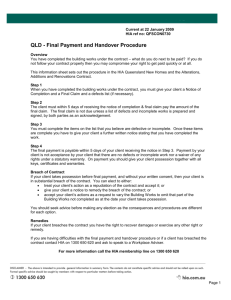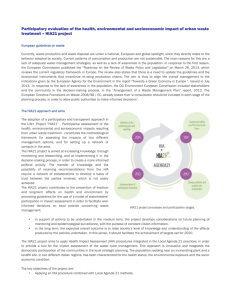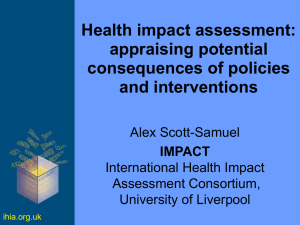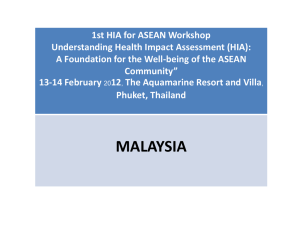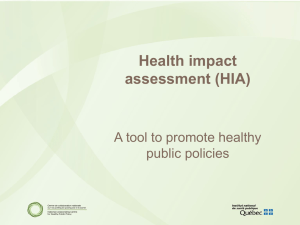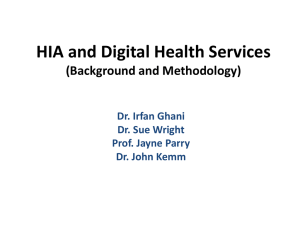Health Impact Assessment Training
advertisement
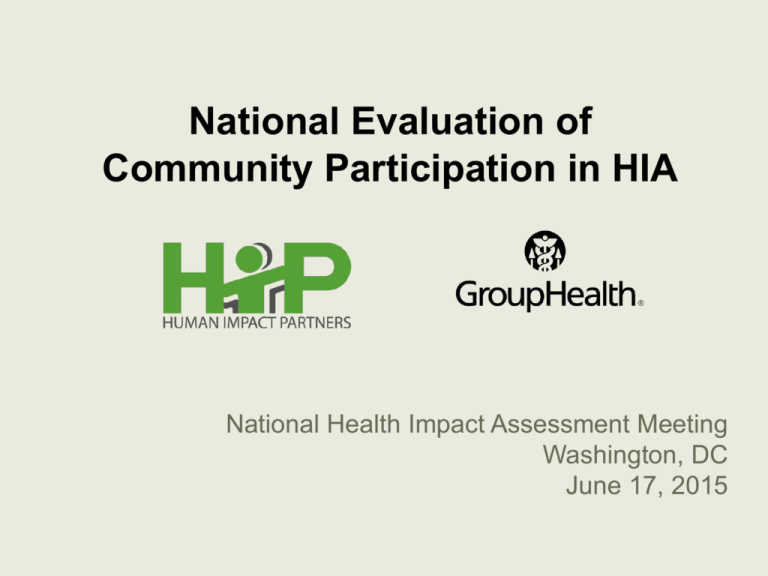
National Evaluation of Community Participation in HIA National Health Impact Assessment Meeting Washington, DC June 17, 2015 1 Project Description Two-year project funded by the W.K Kellogg and Kresge Foundations Conducted by the Center for Community Health and Evaluation and Human Impact Partners Methods: • national survey of completed HIA projects • interviews with experienced practitioners • in-depth case studies of four current HIAs 2 Selection Criteria Selected 47 HIAs completed between January 2010 and September 2013 Diversified sample by sector, geography, and decisionmaking level 3 Survey Respondents 47 HIAs for the survey were identified through the Health Impact Project database Project leads were contacted first, then asked to identify 1-3 community representatives to also take the survey Respondents HIA Team Representatives 30 Community Participants Note: Some respondents were identified by HIA leads as community members, but selfidentified as HIA team members when they completed the survey 63 4 5 Category Goal, Defined by IAP2 HIA Interpretation Inform Provide public with information Provide community with information about the HIA process Consult Obtain feedback from public on analysis, alternatives and/or decisions Feedback obtained: yes, through a few opportunities with limited participation Feedback used: yes or no Community role: not defined Involve Work directly with public throughout process; ensure feedback is understood & considered Feedback obtained: yes Feedback used: yes Community role: clear to all stakeholders & decision-makers Collaborate Partner with public in development of alternatives & identification of preferred solution Feedback obtained: yes Feedback used: yes Community role: clear Decision-making authority: shared Empower Place final decisionmaking in the hands of the public Feedback obtained: yes, in frequent & participatory manner Feedback used: yes Community role: clear Decision-making authority: Community has final authority on HIA decisions 6 Level of Community Participation in HIAs 50% 40% 30% 20% 10% HIA Team Representatives Community Participants 0% Note: Of the 22 HIAs with both types of respondents, we found disagreement about the level of community participation in half (11/22). 7 Level of Participation by Organization Type HIA team members who reported community participation in their HIA was at the level of Collaborate or Empower: Community organization (8/13) 62% Non-profits (3/10) 29% Public health department (3/15) 20% Academic institution (2/10) 20% Other (1/6) Planning agency (0/5) 17% 0% 0% 20% 40% 60% 80% 8 Facilitators of Community Participation Familiarity with the decision-making process (89%) Established relationships (89%) Time (89%) Facilitation expertise (75%) Communications/outreach expertise (67%) Community organizing expertise (64%) 9 Barriers to Community Participation What challenges did incorporating community participation into the HIA lead to, if any? Lack of time and resources – HIA practitioners: 69% – Community members: 35% No negatives to community participation – Community members: 39% – HIA practitioners: 26% Additional barriers for community members: Lack of access to email or the internet (19%) Challenges with transportation (12%) Lack of compensation (12%) “The desire for authentic community participation led to conflicts between the lead HIA practitioner and the agencies overseeing the process.” 10 Compensation to Community Participants According to community participant respondents (N = 30): 70% reported they did not receive any compensation for their participation in the HIA 17% reported that their organization got funding 13% reported that they received money, a gift card, or some other form of compensation 11 Positive Impacts of Community Participation Provided a unique perspective that would have been missed (73%) Decision-makers more receptive to community participation as a result of the HIA (49%) HIA Team members: Increased team member knowledge and/or skills (85%) Established new ongoing partnerships (69%) Community members: Community member feedback incorporated in HIA (77%) Learned how an HIA could affect a decision (65%) “We are now called upon by decision makers to capture community engagement. Also, our community is now receiving much more attention from city agencies.” 12 Civic Agency Because of the HIA, the community … Took action to influence the decision (85%) Reported its individual voices were heard (80%) Acquired an increased awareness of the decisionmaking process (78%) Had increased contact with decision makers (75%) Acquired or strengthened skills that could help them influence future decisions (68%) Got better at organizing to advocate for its interests (43%) 13 Impact of Community Participation on Success of HIA 50% 40% 30% 20% 10% 0% HIA Team Representatives Community Participants 83% of all respondents reported that community participation had a positive impact on the success of the HIA Conclusions Barriers of time and resources were expected Most HIA practitioners are still not paying community members for participation, and community members indicate this is a barrier Compelling benefits of community participation, including increased civic agency and success of HIA Many HIAs are achieving admirable levels of participation, but there is still room for the HIA field to improve overall Collaboration with community organizations may be one key to improvement 15 Coming Soon… Full report with additional findings coming later this year! 16 Report Authors Diana Charbonneau charbonneau.d@ghc.org Kim Gilhuly kim@humanimpact.org Center for Community Health and Evaluation Group Health Research Institute www.cche.org Holly Avey havey@humanimpact.org Human Impact Partners www.humanimpact.org 17 Thank you!! 18 Why Evaluate Community Participation in HIA? Community participation aligns with HIA values of democracy, transparency, and elevating the voices of those who are impacted by decision-making There is anecdotal evidence that community participation can affect the success of an HIA Assess what skills, resources, and expertise are needed 19 Identifying the Impacted Community Most effective strategies for HIA teams to identify who to engage to represent the impacted community • collaborating with local organizations (86%) • collaborating with an interest group affected by a policy (70%) • communicating with individuals (70%) 20 Effective Outreach Methods • Use of community organization(s) (84%) • Networked/mutual contacts (73%) • Public meetings (66%) Community member respondent: “HIA teams should come to us.” 21 Effective Participation Methods Both groups: – Respond to a draft of the HIA (62%) Community participant respondents (N = 28): – Interviews with key people (71%) – Data collection (64%) HIA team respondents (N = 59): – Inclusion on a steering committee (64%) – Public meetings (61%) 22
